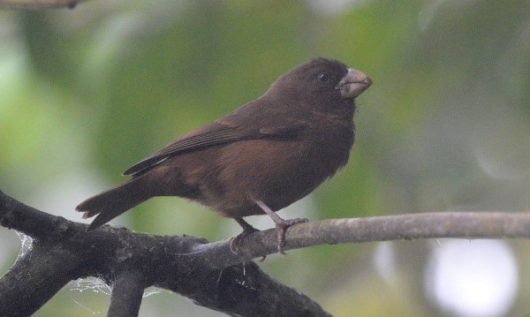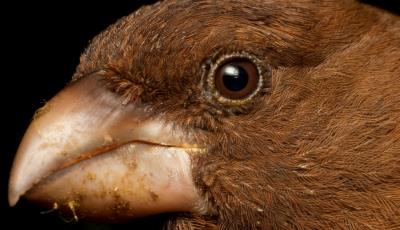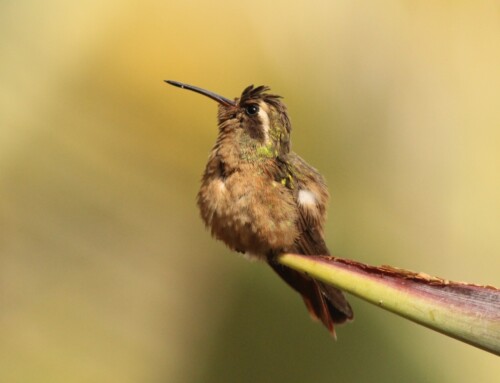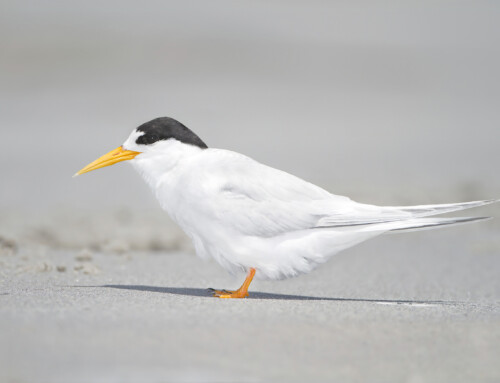The enigmatic São Tomé Grosbeak is the World’s largest canary
LINKED PAPER
The endangered São Tomé Grosbeak Neospiza concolor is the world’s largest canary. Melo, M., Stervander, M., Hansson, B. & Jones, P.J. 2017. IBIS. DOI: 10.1111/ibi.12466 VIEW
The Critically Endangered São Tomé Grosbeak Neospiza concolor ranks high in the select club of the most enigmatic bird species in the world. A recent paper in Ibis has just started unraveling the mystery.
What makes the São Tomé Grosbeak so special?
- It is among the rarest (or least observed) species on Earth
- It was not seen for over 100 years
- Its phylogenetic affinities have remained uncertain since its discovery

In 1888, the Portuguese naturalist Francisco Newton collected a specimen of an unknown bird species on São Tomé. Two years later, he collected another two specimens. Due to its large size and massive bill it was originally described as a weaver (family Ploceidae), close to the Thick-billed Weaver Amblyospiza albifrons. However, not everyone agreed, and there was an argument about whether it was really a weaver or a finch (family Fringillidae). Eventually, most authorities agreed that it was probably a finch, but its affinities were unclear and it was rewarded its own genus, Neospiza – the new finch.
Genetic data was needed to confidently clarify the origins of Neospiza. The challenge lay in obtaining adequate samples. Two of the birds collected by Newton were destroyed in a fire in 1978 at the National Museum of Natural History in Lisbon. Only the type specimen survived, carefully locked away in a fireproof cabinet held at the Natural History Museum ornithology collections in Tring, in the company of other valuable specimens such as the finches collected by Charles Darwin on the Galapagos.
Fresh samples were needed. But this was easier said than done. At the time of its discovery, Newton had already considered this new species to be extremely rare, but he certainly did not suspect that it would take over 100 years before it was going to be seen again – rediscovered by Dave Sergeant and three other birders in 1991! Finding São Tomé grosbeaks is a true challenge, and catching them even harder: it took many field seasons in the rainforests of São Tomé (where it has been said that it may rain up to 9,000 mm per year) to be able to mist-net the three individuals that provided the samples used in the IBIS paper.

Together with Bengt Hansson and Peter Jones, we have used DNA sequencing to establish once and for all what the São Tomé Grosbeak really is. We have sequenced a wealth of mitochondrial and nuclear DNA markers, and typed several microsatellite loci. The results are clear: the São Tomé Grosbeak is indeed a finch (family Fringillidae). Further, it is nested within the seedeater genus Crithagra, and should thus no longer be called Neospiza. More interestingly, was the fact that the closest living relative of the São Tomé Grosbeak occurs side by side with it: it is the Príncipe Seedeater Crithagra rufobrunnea, another endemic species that inhabits both São Tomé and the neighbouring island of Príncipe. This opens up very interesting questions about which scenario led to the colonization of two sister species in the same island. Genomic data is currently being analysed to disentangle the details of this story.

The São Tomé Grosbeak breaks the previous world record in body size among seedeaters and canaries (in a wider sense, including the genera Crithagra and Serinus) by far! With its 50 g, it is double the weight of the Príncipe Seedeater, which was already the world’s third largest canary. With this, the grosbeak joins the club of other endemic giant species on São Tomé, such as the Giant Sunbird Dreptes thomensis and the Giant Weaver Ploceus grandis. They all represent cases of the fascinating island gigantism phenomenon.
So, the beautiful genus name Neospiza is now out of the game, and our enigmatic bird should henceforth be called Crithagra concolor. A change that was quickly adopted by the major bird checklists of the world.

Intense survey efforts coordinated by Ricardo Lima and BirdLife International in collaboration with the Association Monte Pico from São Tomé, have led to a better understanding of the distribution of the São Tomé Grosbeak. The conclusion remains that it is the most difficult to observe bird on the island and no clear pattern of habitat preference has emerged – even if it is clear that the primary forest is essential. The good news is that its population size is likely higher than the official estimate of less than 50 individuals. Our own unpublished genetic data has shown surprisingly high levels of genetic variation for what should be a very rare species with a tiny population size. This information, together with the unpredictable location of sightings, lends hope to the hypothesis that the São Tomé Grosbeak rather than being extremely rare is simply a very difficult species to observe – maybe a canopy specialist that only occasionally comes down to delight us.
Further reading
A brief introduction to the unique bird life of São Tomé and Príncipe Islands:
Melo, M. & Ryan, P. 2012. Endemism gone wild: The forgotten bird islands of São Tomé and Príncipe. Africa – Birds & Birding 17(2): 32-41. VIEW
Dean Amadon did the first synthesis on the avifauna of the islands…
Amadon, D. 1953. Avian systematics and evolution in the Gulf of Guinea. Bull. Am. Mus. Nat. Hist. 100: 394–451. VIEW
… and later comes back to the relationships of the São Tomé Grosbeak:
Amadon, D. 1965. Position of the genus Neospiza Salvadori. Ibis 107: 395–396. VIEW
Abbé René de Naurois was the last ornithologist to have inspected the three specimens collected by Francisco Newton, before the two kept in Lisbon were destroyed in the 1978 fire. He published an important but hard to find reference:
de Naurois, R. 1988. Neospiza concolor (Bocage, 1888): Endémique de l’île de São Tomé (Golfe de Guinée). Mus. Reg. Sci. Nat. Boll. (Torino) 6: 321–339.
Image credit
Featured image: São Tomé Grosbeak Crithagra concolor; previously Neospiza concolor © Alexandre Vaz
If you want to write about your research in #theBOUblog, then please see here.





